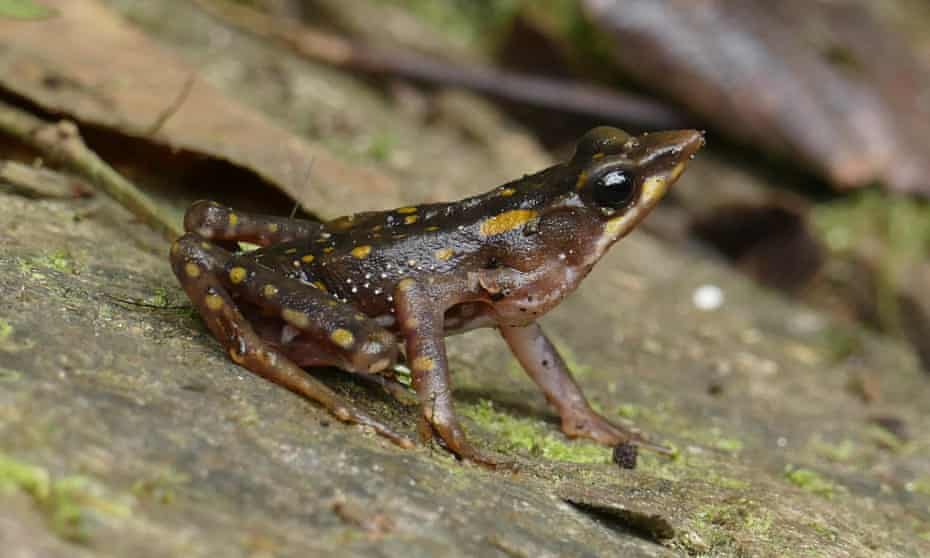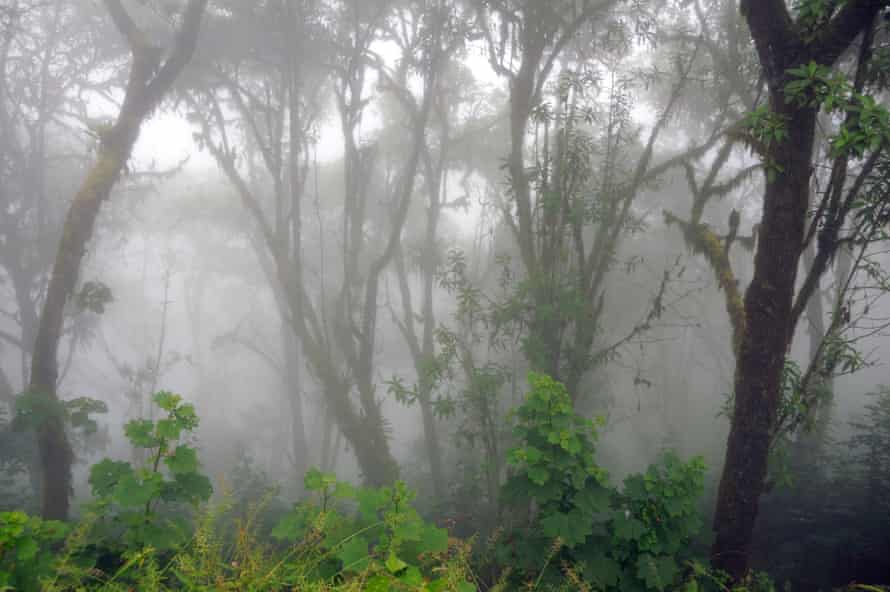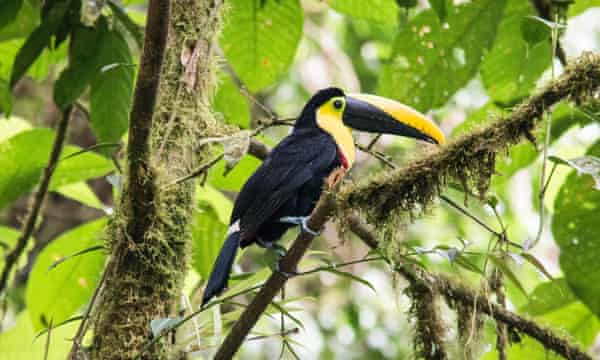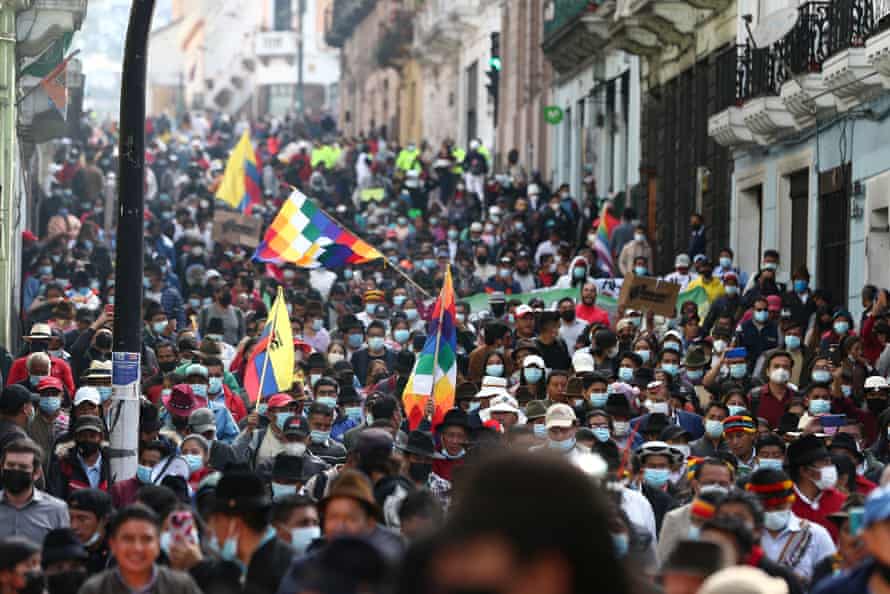Frog back from the dead helps fight plans for mine in Ecuador
Campaigners say if copper mine gets go-ahead in cloud forest, the longnose harlequin, once thought to be extinct, will be threatened again

Reports of the longnose harlequin frog’s death appear to have been greatly exaggerated – or, at least, premature. The Mark Twain of the frog world is listed by the International Union for Conservation of Nature (IUCN) as extinct, which may come as a surprise to those alive and well in the cloud forests of Ecuador’s tropical Andes.
Known for its pointed snout, the longnose harlequin frog (Atelopus longirostris) is about to play a central role in a legal battle to stop a mining project in the Intag valley in Imbabura province, which campaigners say would be a disaster for the highly biodiverse cloud forests.
“Ecuador is wildly diverse with amphibians,” says Carlos Zorrilla, executive director of environmental organisation Decoin (Defensa y Conservacion Ecologica de Intag). In 2016, four longnose harlequin frogs – last seen in 1989 – were found in the area. “Elicio Tapia and Gustavo Pazmino, the biologists from Jambatu Centre for Research and Conservation of Amphibians, who found them, also believe there’ll be dozens more amphibians endangered by this mining project,” says Zorrilla. “Mining would violate the ‘rights of nature’, which are enshrined in Ecuador’s constitution. This is a good argument to halt mining at this site.”
In 2008, Ecuador became the first country in the world to recognise the rights of nature in its constitution, acknowledging that all nature has the right to exist and to receive state protection. Article 73 says: “The state shall apply preventive and restrictive measures on activities that might lead to the extinction of species, the destruction of ecosystems and the permanent alteration of natural cycles.”
The concession area for the planned Llurimagua copper opencast mine – a joint project between the state-owned Chilean mining company Codelco, the world’s largest copper producer, and Ecuador’s state-owned Enami – is primary cloud forest, a fragile ecosystem found in high mountainous tropical regions, usually between 1,000-3,000 metres above sea level, with heavy rainfall and persistent cloud and mist at the canopy level, meaning humid, moist environments where wildlife thrives.

Less than 2.5% of the world’s tropical forests are estimated to be cloud forests but they contain a disproportionately large number of the world’s species.
Researchers at the Jambatu Centre believe Intag could be functioning as a “frog ark”, where the fatal fungal disease chytrid has not yet wiped out amphibian populations. The critically endangered Lynch glass frog has been reported here, as has a frog originally thought to be the Confusing rocket frog, but now believed to be a species that is new to science.
Frogs are just part of the picture. “We’re within the most biodiverse of the world’s biodiversity hotspots: the tropical Andes,” says Zorrilla, who has lived on his farm in Intag for 43 years, though he is originally from Cuba. “This is one of the biological jewels of the world,” he says, adding that the number of endemic species in that part of Ecuador is higher than even the lowland Amazon.

Among the animals that live in the area are the brown-faced spider monkey; the Andean, or spectacled, bear; the black-and-chestnut eagle; the puma; the white-faced, or Panamanian, capuchin monkey; the Choco toucan, and Andean catfish.
“There are also two endangered tree species, and the region is one of the most biodiverse for orchids,” Zorrilla adds. “There are 43 sources of rivers and streams within this one single mining concession, which is less than 5,000 hectares [20 sq miles].
“It’s extremely steep and mountainous, with heavy rainfall – a nightmare scenario for mining,” he says. “Communities would have to be relocated. It’s going to devastate a biological jewel, displace people and we’ll be left with all the environmental liabilities.”
Zorrilla is leading a team of lawyers and members of the local community to present their legal case to block the Llurimagua concession within the next few weeks. While the project has stalled, due to a disagreement between Codelco and Enami, the campaign to block the proposed mine permanently is continuing.
There are four plaintiffs, including two farmers, a community leader from the Intag valley town of Chalguayaco Alto, and Javier Ramirez, a community leader who was previously jailed for an anti-mining protest in Intag.
Zorrilla says: “We’ll present the case at the lower court for Cotacachi county government, then provincial courts. And if we lose there, which I don’t think we will, it will go to the constitutional court in Quito, the highest court in the land. I think we’ll win.”
Since coming to power in May, Ecuador’s president, Guillermo Lasso, a former banker, has signed two presidential decrees, including Decree 151, which supports the development of mining in the country and was widely welcomed by the mining sector.

In October, indigenous communities were among those that took to the streets of the capital, Quito, to protest rising fuel prices and other economic issues. “These decrees are one of the reasons why there’s a major national strike in Ecuador,” argues Zorrilla. “Indigenous people and campesino groups oppose these decrees because of the expansion of petroleum and mining activity in indigenous land, campesino land and protected areas.”
Ecuadorian politician, indigenous leader and environmental lawyer Yaku Perez, who ran for president this year, says: “The mining decree is a declaration of war on the defenders of water and nature. It’s harmful to the rights of indigenous and non-indigenous peoples alike.
“Mining leaves indelible traces wherever it goes: environmental pollution, poisoned water, violence, dispossession. And in order to open mines, they must deforest forests and ecosystems, which generates more greenhouse gases and global warming. That’s why the cry of the Earth is the cry of the poor who resist in order to live.”
Mario Ruiz Jacome, a member of the national assembly for Imbabura province, says: “We oppose Decree 151 because it clearly accelerates the extractivist process in our country.”
The longnose harlequin frog versus Llurimagua concession is not the only legal battle of its kind in Ecuador, says Zorrilla. “There are three protected areas declared by the minister of the environment, including ours, which are being given away.
“In Ecuador and the world over, we need to draw red lines and say areas like this, with high biodiversity and indigenous people, should be off limits.”